Here is your big chance to buy unique fruits from faraway places. Tropical fruits are in season now.
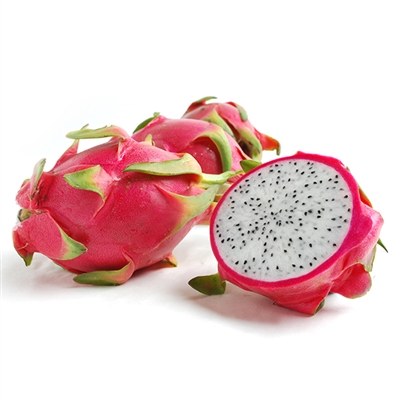
Dragon Fruit:
The Dragon Fruit is an exotic cactus fruit that has a delicately sweet and mildly acidic flavor, reminiscent of watermelon, cactus pear, and kiwi. The fruit itself is round and its exterior ranges in color from a hot pink to red. The interior color of dragon fruit ranges from white to pink to magenta. All three types have tiny, edible black seeds (very similar to those found inside Kiwi). This fruit does not grow well in winter cold or summer heat, so its availability is limited, making it a highly prized treat. The melon-like texture of the Dragon Fruit makes it ideal for blending in drinks as well as using in sorbets.
Our Dragon Fruit is hand-selected for excellent quality. Dragon Fruit should be kept refrigerated, unwashed, for up to 5 days. Best served chilled.
Imported Dragon Fruit (white flesh) is available year round.
Domestic Dragon Fruit (white flesh and Magenta flesh) is only available Aug-Dec typically.
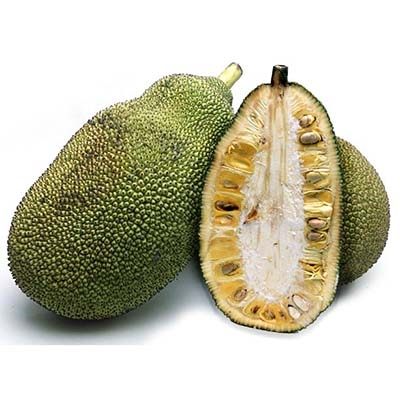
Jackfruit:
Jackfruit is the world’s largest tree fruit, averaging between 15 and 33 pounds per fruit. This large fruit grows directly out of the trunk or branches. The exterior of the Jackfruit is covered with spiny, knobby bumps and is green in color.
As the fruit ripens the skin turns to a yellow color and is very fragrant. The pink or yellow flesh is best when eaten fresh with hints of mango and melon.
Jackfruit can also be enjoyed unripe, cooked in various recipes. The flesh of the Jackfruit can be used in desserts, as well. This soft, flaky, sweet fruit can be a delight for any meal. The many seeds in the Jackfruit are sensational when roasted, similar to a chestnut in flavor. Refrigerate Jackfruit. Choose Jackfruit with a strong fragrance and a deep yellow color.

Kiwi:
Kiwis have a juicy, slightly tart flavor reminiscent of melon and fresh berries. Kiwis have more Vitamin C than citrus and can be used in marinades as a meat tenderizer.
Beautiful and eye-catching when sliced and used as a garnish, the crunchy, tiny black seeds add a wonderful texture and are perfectly designed to be eaten!
Our Kiwis are hand selected for excellent quality. Harvested when ripe and firm, choose solid, unblemished fruit.
With a very long shelf life, Kiwis can be refrigerated for two or three weeks and then stored at room temperature for a few days until they yield to gentle pressure. Kiwis continue to get juicier when kept at room temperature.
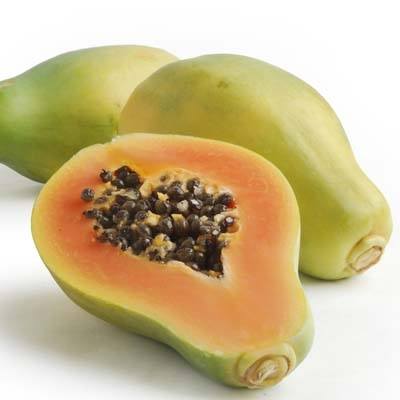
Strawberry Papaya:
Native to tropical regions, papayas can now be found growing in Hawaii, Mexico, Puerto Rico, Florida, Southern California and Brazil. Considered to be the sweetest, most flavorful of all Papayas, the salmon-red to pink flesh of the Strawberry Papayas is fragrant and juicy, with a hint of fresh peaches and berries.
Delicious with a simple squeeze of fresh lime or added to smoothies and salads, cubes of Melissa’s Strawberry Papaya can also be added to fresh pineapple, peppers, pearl onions, and teardrop tomatoes for a unique fruit kabob for the grill. Once soft to the touch, cut in half lengthwise and scoop out the small black seeds from the center.
When selecting Papayas, choose those that are soft to the touch (similar to a ripe peach). Their color should be more yellow than green. Ripen firm Papayas at room temperature in a loosely closed plastic bag. Refrigerate ripe fruit in a plastic or paper bag for up to 3 days. Freezing is not recommended.
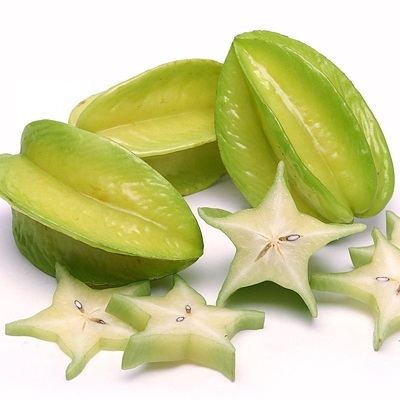
Starfruit:
Beautiful, unusual Starfruit—also known as Carambola—gets its name from its five-pointed shape, which yields slices of juicy, lush translucent stars. The fruit ripens to a bright, light yellow and begins to exude a light, tropical aroma. Sweet and mild, the flavor has been compared to plums, grapes, pineapple and pear, with notes of lemon and tropical breezes.
Elevate your cooking with Starfruit’s unique shapes and flavor, for instance by making a Starfruit Upside-Down Cake. Or, create an elegant Starfruit mosaic atop a frosted cake or glazed tart. On a savory note, Starfruit can pair nicely with fish. Try serving fish on a bed of starfruit to subtly impart fruity flavors to the finished dish, and then topping it with a star-fruit salsa.
Usually sliced fresh as an elegant addition to salads, buffet platters and desserts.
Star Fruit are hand-selected for excellent quality. Choose firm, glossy-skinned fruit with no signs of bruising. Note that browning on the tips of the ridges is simply a sign of ripeness. Keep refrigerated in a paper or plastic bag for about one week. Slices may also be frozen.
Except for the seeds, the entire Star Fruit is edible. After washing, Star Fruit may be enjoyed eaten out of hand or the peel skin and slice into a fruit salad.
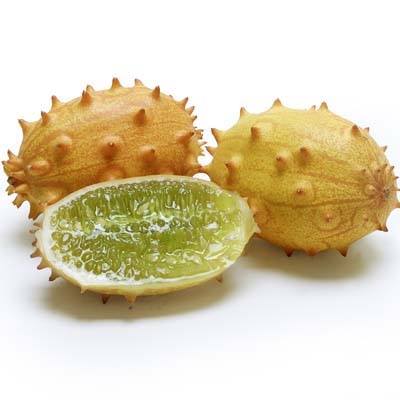
Kiwano Melon
Once grown only in New Zealand, Kiwano Melons are now grown in California as well. Consumers are drawn to these intriguing, yet versatile tropical fruits whose look easily captures attention. The spiky, orange colored shells of Kiwano Melons encase a soft, succulent bright green flesh. Kiwano Melons are mild in flavor and similar in taste to juicy, seed-filled cucumbers. Once peeled, Kiwano Melons can be tossed in fresh fruit salads or served as a garnish with roasted meats.
For over 3,000 years, this African Horned Melon or Kiwano Melon has been fascinating the produce world. The spiky, golden-orange shell encases a soft, succulent, seed-filled emerald green interior. Its flavor is reminiscent of a cucumber, with notes of melon and lime. This fruit’s versatility extends beyond simply eating it. Cut in half and scoop out the translucent jelly-like flesh to create a unique, striking serving cup.
Ripe Horned Melons will have a bright orange shell. Avoid any bruising or soft spots. No need to refrigerate. The seeds are edible. Kiwano Melon shells can be used as unique serving bowls for soups, sorbets and desserts.

Honey Mangoes:
The mango, a native of India and cultivated in Asia for over four thousand years, is grown around the world, including areas of Mexico, California and Florida.
The Honey Mango is small, delicately shaped, with skin that ripens to a golden yellow. Sometimes referred to as “champagne” mango, its flesh is velvety smooth with almost no fibrous texture and with a wafer-thin pit. An important fruit for many tropical countries, the mango contains enzymes useful for tenderizing meats that also acts as a digestive aid.
Mango may be added to salads or used in vegetable or poultry dishes.
Our Mangoes are hand selected for excellent quality. Choose fruit that are firm, have unblemished skin and a fresh scent.
Since Honey Mangoes are usually sold firm, leave at room temperature for several days to soften until they yield to gentle pressure and the skin wrinkles. Once ripe, refrigerate for up to a week.
Honey mangoes are also known as Ataulfo Mangoes.

